RADIATION
We often hear that the zone is safe. When you visit with a guide who forbids you to enter any buildings, of course there’s nothing to worry about. The ban on entering buildings, preceded by an earlier ban on going onto the roofs, is slowly becoming the norm for tourist groups. The regulation has been in effect for a long time, but it’s being implemented more often. This comes as no surprise, if you look at the increasingly decrepit buildings.

School no. 1 in Pripyat. In the middle of the picture you can see the remnants of a demolition from 2005. Behind the building you can see a demolition from 2013, as well as in the lower building on the right side of the picture.

Fragment of a school demolished in spring.
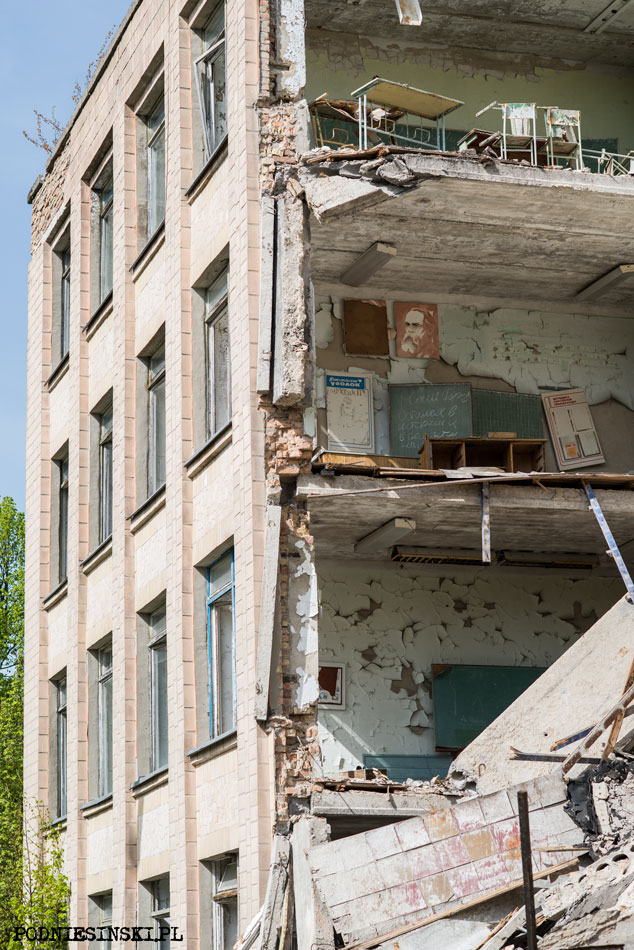

Before the school is completely torn down, I’ll check the basement. I was in it once, but this time I manage to find a room with cross country skis and many banners.
But the increasingly bad state of the buildings is not the biggest risk we may face in the zone. Radiation is much more serious. Despite the fact that the average radiation is many times higher than in the cities we live in, it’s still considered safe by experts. But what if some tourist, unaware of the dangers, gets separated from the group and walks, unprotected, into one of the contaminated rooms? For example, the cellar of the hospital in Pripyat, where he could unwittingly kick up, and then breathe in, radioactive dust which covers the firefighters’ uniforms that are lying around there. There are more rooms like this in the zone. Most of you have surely heard about Jupiter, the factory which officially produced radios, and secretly produced military equipment. Maybe you also saw it in the first part of Alone in the Zone where I visited the underground laboratory for the first time, examining the hundreds of mysterious substances that were there. This time I check a part of the cellar that escaped my attention the first time, or rather, the attention of my dosimeter. In the labyrinth of narrow hallways and small rooms, it’s easy to get disoriented and miss places which still hide radioactive secrets. Unfortunately, in spring the whole underground laboratory is flooded, and partially frozen. Fortunately, I’m prepared for such a possibility, I have galoshes that I sealed with duct tape, at the same time attaching them to protective overalls. Despite that, the level of water in some places is so high that the water gets into my galoshes. But I have a stroke of luck, I find a room where there are several metal boxes behind a metal net and cupboard relatively quickly. Still several hundred meters away, the dosimeter informs me of the increasing level of radiation. A sign that I’m close.
One of the boxes is open. The contents look like silver dust, but it could also be grains of some kind of metal. Intriguing, especially because the dosimeter goes crazy when brought close to the material. I’m holding a pre-prepared sack in which I collect a sample of the mysterious substance. I intend to study its origin using a spectrometer.

The radiation level of the mysterious silver dust reaches 1 232 uSv/h.

Cellar in Jupiter. Frozen masks.
But don’t think that just not going into the cellar is enough to protect you from radiation. There are much more dangerous radioactive places in the zone. One is right by the power plant where hundreds of tonnes of fuel containing materials ended up as a result of the disaster. The explosion and fire caused the lighter materials to reach the atmosphere and the airstream, which spread it across a large part of Europe. The larger and heavier materials fell close to the power plant, contaminating tens of thousands of hectares of nearby forests. The forests were divided into 4 zones based on the level of contamination. The first, smallest but most highly contaminated zone covers 400 ha of forests located directly next to the power plant. In this area all coniferous trees (trunks) died and their needles turned red. Hence the name Red Forest. Shortly after the disaster the decision was made to cut down and bury all of the dead trees. Leaving them there created a risk of re-distributing the radiation, for example, as a result of them bursting into flames. The contamination of the terrain also created a problem for the nearby roads leading to the power plant. Cutting down and burying the trees also significantly decreased the level of radiation, which is currently around 20-30 uSv/h. Despite this, the trees buried under the ground (more precisely, radionuclides), which are an exceptional form of biomass, reach new trees through the root system along with substance they feed on, and cause internal radiation and mutation in them. So, is it just the radionuclides concentrated in the biomass which comes from the buried, old trees that is the source of such high radiation? I decided to go to the Red Forest and make a more in-depth search for answers.

Temporary radioactive waste storage site ‒ Red Forest
The first thing that surprises me is how easy it is to find a place where the radiation is so different (higher) from the previously mentioned background radiation in the Red Forest (20-30 uSv/h). After just a few minutes of searching, the radiation under one of the trees reaches 5 000 uSv/h, approximately 200 times higher than the background radiation in the forest. A good foothold, I thought, starting to dig out a fragment of the radioactive ground. Such a high level of radiation may be a result of a high concentration of contaminated biomass/soil, and could also be a signal that there is a fragment of some inorganic material, e.g. a piece of metal, under a layer of ground. Systematically testing every piece of earth with the dosimeter after a few minutes leads to a significantly higher reading on the trowel. I’ve got something. I leave the forest quickly and then put the piece of earth on the asphalt to make it easier to search further. I divide the piece in two and I check which piece is more radioactive. I throw the less radioactive piece aside and divide the more radioactive one in half again and I repeat the whole operation until I notice a small, grey grain the size of a sunflower seed in a small piece of earth. Before I’ve completely cleaned all the earth off the fragment I found, the radiation is approx. 25 mSv/h (25 000 uSv/h), and so it’s approx. 5 times higher than the dug up ground and 1 000 higher than the background radiation in the Red forest (or approx. 100 000 times higher than the background radiation in the cities we live in). But when I’ve completely separated the fragment from the rest of the earth sticking to it and measure the radiation, my blood pressure spikes. The dosimeter is going wild. The initially very quick beeping of the dosimeter turns into one long whistle. I check twice and I can’t believe it – the dosimeter reading is over 500 mSv/h (500 000 uSv/h). Then the dosimeter changes its scale from mSv to Sv, but instead of a reading the machine resets itself, showing four lines (- – – -). In any event, I move back and analyse the situation again. Fuck! ‒ I can’t help but exclaim. I’ve never seen anything so radioactive in my life! It looks like I accidentally acquired a fragment of fuel from reactor 4 (or a fragment of irradiated graphite). Nothing else could be so radioactive. Once the dosimeter exceeded 500 mSv/h and then changed scale to Sv and turned itself off, the radiation in the fragment is probably measured in Sv/h!

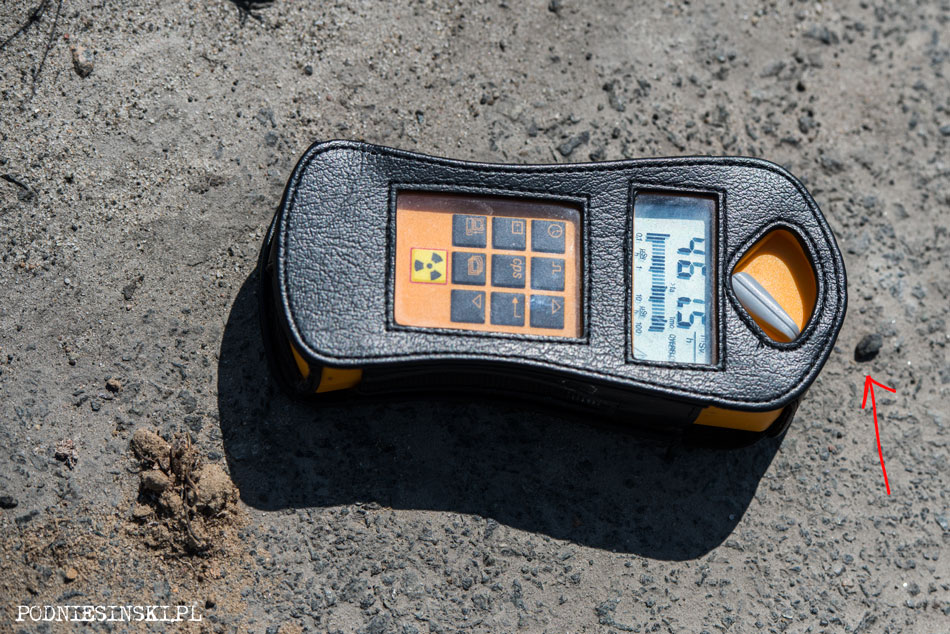
461 mSv/h ‒ the red arrow points to the fragment of fuel from reactor 4.

Only when I come face to face with how such a small, inconspicuous grain can generate such huge radiation, do I start to reflect. It’s so small, yet capable of generating such a huge amount of energy. And treating it carelessly can cause so much damage, even kill. Radiation is invisible, imperceptible, odourless, soundless ‒ without a dosimeter we’re blind to it, and indeed none of our senses can detect it. Previously I only knew it in theory, now I’ve experienced it live ‒ it’s like finding out about it all over again.
Over a quarter of a century ago, bio-workers experienced this same thing, the volunteers cleaning the roof of the power plant of the most radioactive remnants of the explosion. They didn’t just take one grain, but full shovels of even more radioactive materials, I-131, which has already dissolved, or Cs-137, whose current activeness is two times lower than at that time (its half-life is approx. 30 years).
A moment later I start to have doubts. The dosimeter I’m using (Gamma Scout) is one of the best on the market. But even this has its limits. Above all, it’s not adapted to measuring such high radiation. It’s only calibrated to 1 mSv, so you can’t completely trust readings higher than that value. Also, whether the dosimeter (tube) and the application of appropriate algorithms in programming is capable of counting and calculating cps (counts per second) in Sv. To put it briefly, when overloaded with such a huge number of cps, will the dosimeter overestimate or underestimate the measurements? I have no way to check at the moment. So the next day I borrow another dosimeter used by the dosimeter operators who measure the contamination of cars leaving the zone. I take the measurements again, which unfortunately don’t assuage my doubts. So before I come to any final conclusions, I decide to wait and after I return carefully check the recorded film, analyse the readings from both dosimeters (and the logs from the GS), particularly the readings from various distances from the sample, and to contact the manufacturer of the equipment. I hope I manage before the premier of Alone 2.
CHERNOBYL-2
I love coming back to places that particularly interest me. Places that have their secrets. One of these is the town of Chernobyl-2. The place where the DUGA-3 over-the-horizon radar is, which I have visited many times. But I’ve never fully seen it. This time I decide to catch up and I visit it three times. And you know what? It’s still not enough!

Lecture hall of the DUGA complex

One of the rooms in the main building where work on radio-telecommunications equipment is managed.

One of the rooms where the engines/generators of the complex are overseen.
Chernobyl-2 was a huge complex consisting of two parts ‒ the military part where there were the radar structure and military buildings, and civilian buildings where the soldiers servicing the radar lived with their families and children. And this part is the main reason behind my return to this place. I don’t just find residential buildings, but also a school, kindergarten, hotel, club with a cinema, a gym and shops. Because the building is closed, guarded and inaccessible to most, you can still find really well preserved objects there. For example, a working piano. If only I still knew how to play…
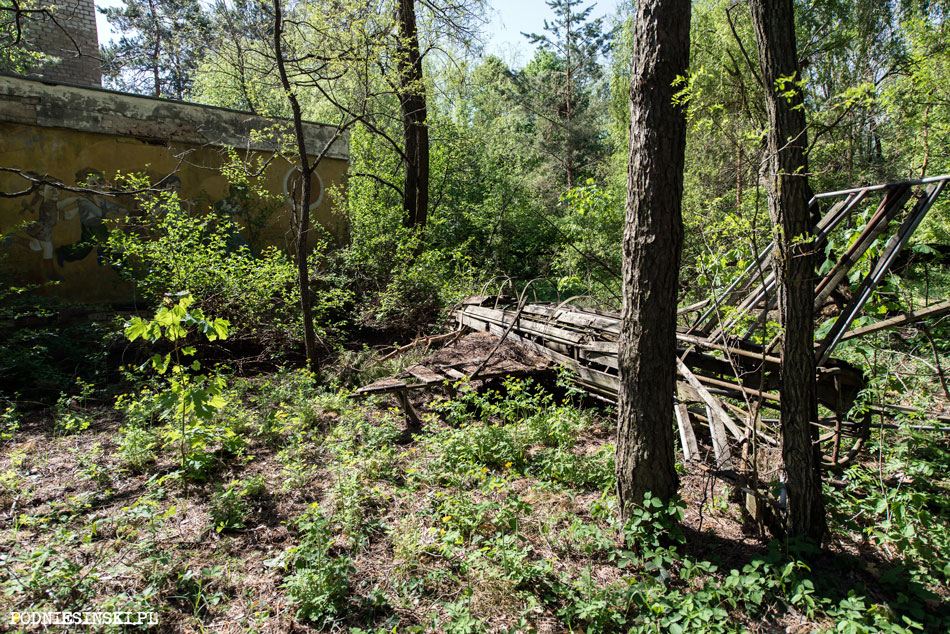
Playground ‒ kindergarten in the Chernobyl-2 complex. Even the toys have a military context.

Shop where the remains of military electronic equipment are stored.

Multifunctional hall where there used to be a cinema, concerts and other events.

View from the back.
Between the military and civilian sections, there is a football pitch which the residents of the complex used in their free time. But the inconspicuous pitch hides a secret. There’s a shelter under the grass. But I’ve never been able to determine what it hides or where the entrance is. And the whole shelter is probably flooded. But that’s not a problem. The perceptive reader may notice that I recently did a course in cave diving. And caves aren’t the only place you can dive once you have training and the appropriate certificate. In its textbook definition, the course relates to diving in all places where there’s a roof above the diving site which prevents freely swimming to the surface. So, if I can just find the entrance the course will be perfect.
Of course, my thorough visit to the whole complex didn’t prevent me from going on the smaller antenna. I haven’t been on it yet.


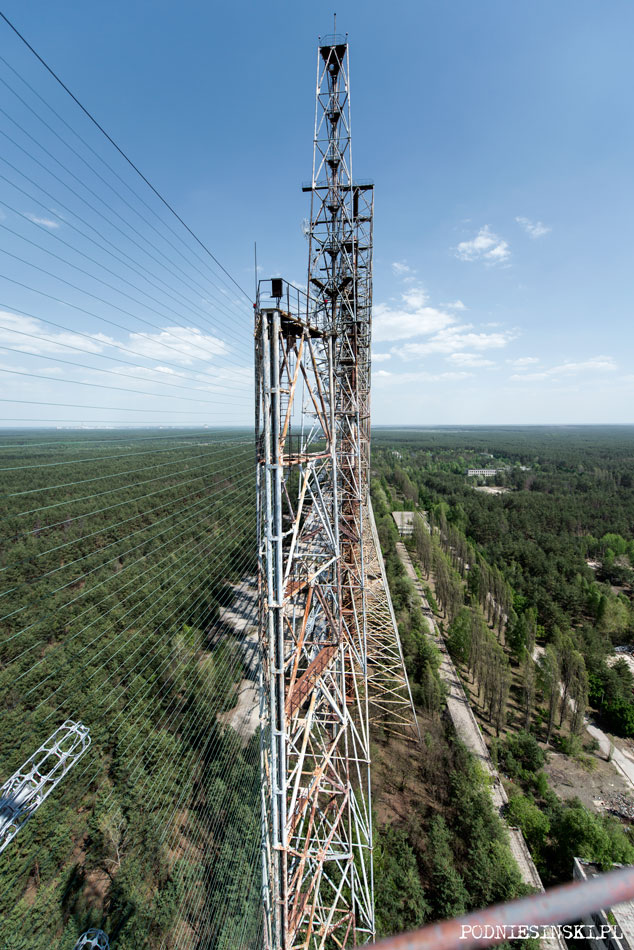


COOLING TOWERS
Since we’re talking about climbing, surely everyone who has visited the Chernobyl zone has seen the cooling towers. If not from close up, then at least from the road leading to the power plant. I’ve come back to this place many times myself, if nothing else than to hear the excellent acoustics inside the towers. The cawing of crows flying many metres above can be heard perfectly at the base of the tower. On a tour, or without, in pictures or film, everyone’s seen the tower. But no one has seen the views from the cooling tower, or more precisely, from the top of it. At least, not since the disaster. A dangerous task, but possible with the right preparations. The only way to get to the top of the tower is a ladder attached to the outside. Climbing along it is no particular challenge. The big challenge is crossing the wooden balcony (floor) at the top, and along the peak of the building itself. I devoted one of my previous trips to photographing the balconies in detail so as to assess the success and risk of the whole operation from up close. This spring I’m ready.






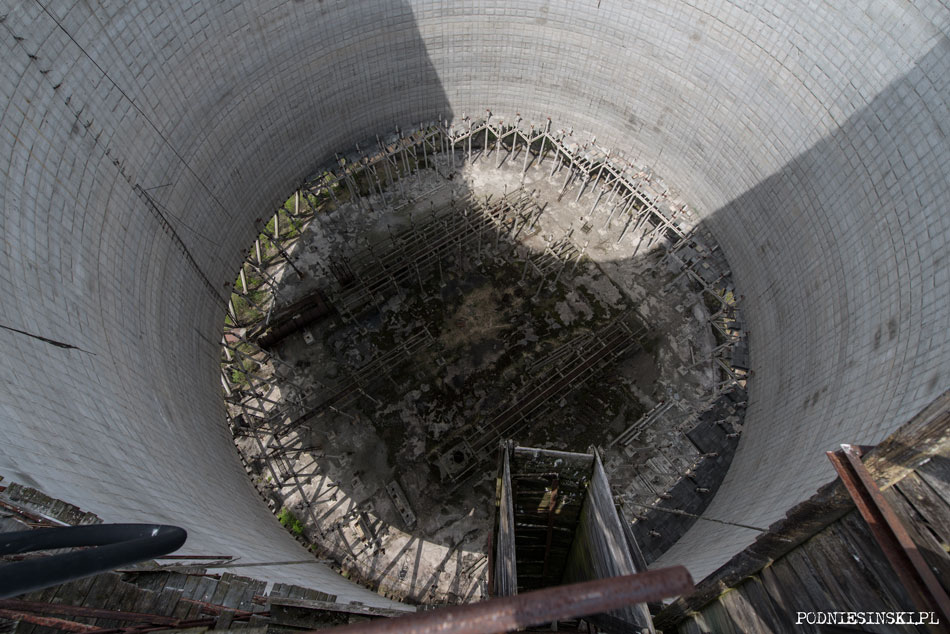


The exciting entry onto the top will be on film soon.
ROSOCHA
Do you remember my report from by autumn trip to the zone called „Heroes of a Non-Existing Country”? In this I described the story of the pilots who took part in eliminating the effects of the disaster. I took some unique pictures then. Unique because it’s very rare to get permission to enter the area of the cemetery. But they will only become truly unique once all the helicopters have disappeared. Yes, they have disappeared. They were cut up, decontaminated and scrapped. Rosocha itself has officially ceased to exist. The end. In autumn there were still a few dozen other vehicles next to several helicopters. They’ve also disappeared. On the huge square, about ten hectares large, where there were once over 1500 machines, now only one remains. A partially cut-up helicopter. A truly surreal view if we imagine that there were so many machines here so recently. Therefore, the pictures I took in autumn, like the pictures of the barges in the river port in Chernobyl, have joined the ranks of historical photographs. From the business and photographic point of view, I should be happy, from now on the pictures will be more valuable. But the sentiment, and above all the desire to save all these disappearing places, objects and people and their tragic history from oblivion is the most important thing for me.

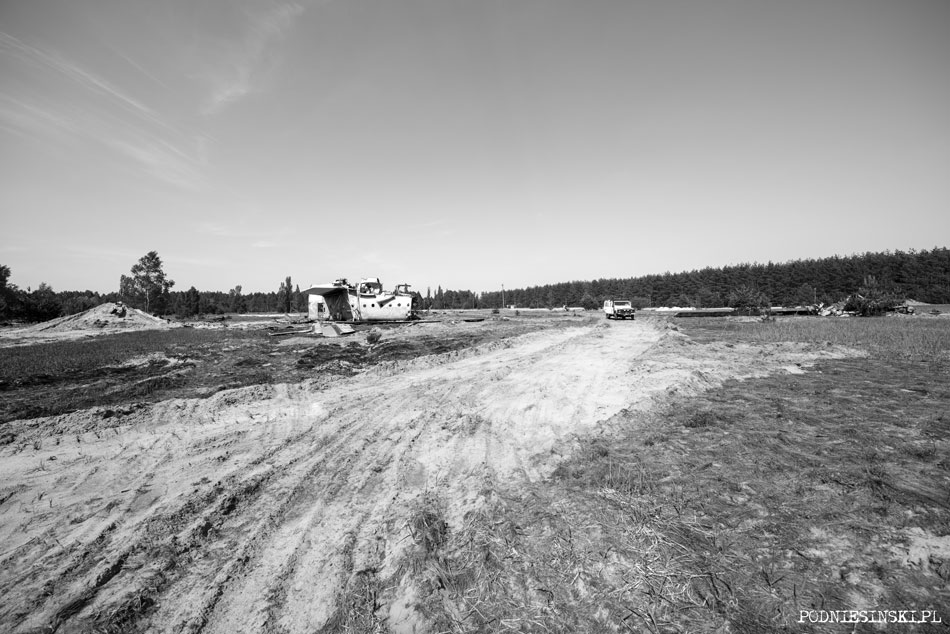
BUT THAT’S STILL NOT THE END
As you may suspect, I devoted a large part of this last trip to pictures for the second part of the film. That’s why I can’t write about everything, and I deliberately skipped over several issues. After all, I don’t want to spoil the surprise! I get more and more emails asking about the premiere date of Alone in the Zone 2. So I will say in response that it’s swiftly approaching. Maybe not as swiftly as you would like, but if someone asks you what you want for Christmas, you know what to tell them :) Of course, only for the people who have the first part of the film. There are still a few copies if someone wants to see Alone 2 but doesn’t have Alone 1, please click HERE.
Rest assured, it will happen!
P.S.
If you’re a photographer (over 25 years of age) and you want to join one of the coming trips to the zone (in autumn), send a few words about yourself to arek (at) podniesinski (dot) pl.



